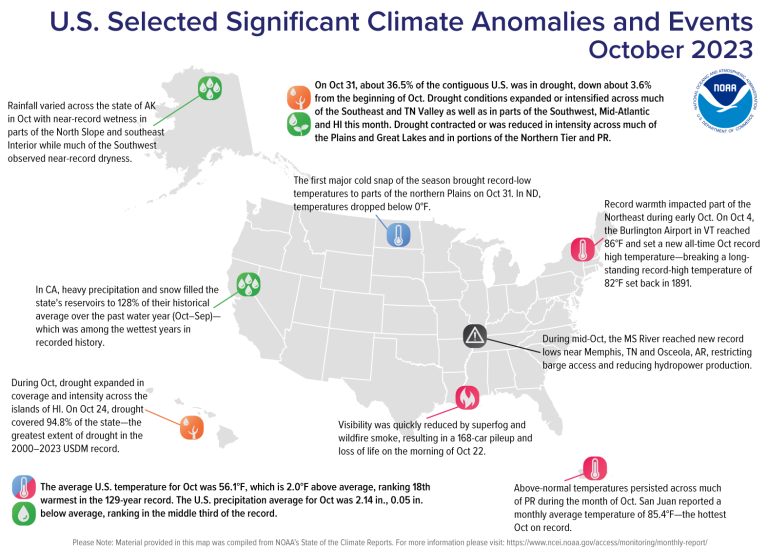the main points:
- For the second year in a row, the Mississippi River has dropped to record levels, causing barges and ships to run aground during one of the busiest times of the year for shipping grain.
- The first major cold snap of the season occurred on October 31 and into early November. Temperatures were 20-30 degrees Fahrenheit below average across much of the United States, bringing record low temperatures and snowfall from the northwest to the southeast.
- Year-to-date temperatures across the eastern United States have been warmer than average in 2023, with 30 states in the top 10 experiencing warmest from January to October.
- A total of 25 separate climate disasters worth $1 billion have been confirmed this year – the largest number of events on record in a single calendar year.
- October 2023 was the 18th warmest October on record for the state, and precipitation ranked in the middle third of the historical record for the month.

Other highlights:
Temperature
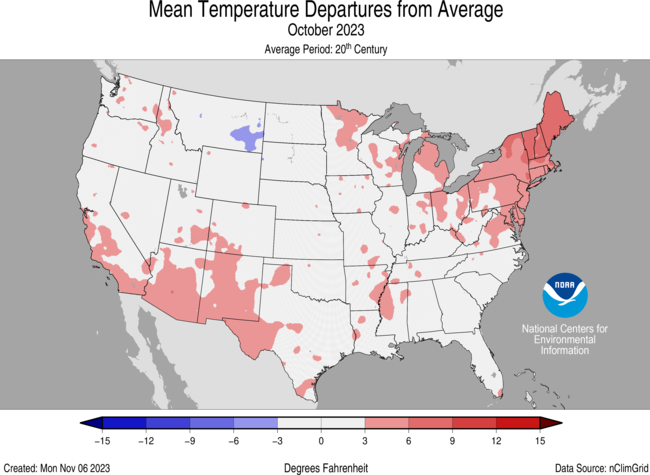
The average temperature in the contiguous United States in October was 56.1°F, 2.0°F above average, ranking it 18th warmest in the 129-year record. Overall, October temperatures were above average across most of the contiguous United States, with below-average temperatures in parts of the central and northern Plains. Maine ranked second on the list of warmest October on record, while Vermont and New Hampshire both ranked third on the list of warmest on record. Six additional states ranked among the ten hottest Octobers on record.
Alaska's statewide October temperature was 27.8°F, 2.3°F above the long-term average, ranking third in the 99-year period on record for the state. Near-normal temperatures were observed across much of the state, with higher-than-normal temperatures observed in parts of the northwest, southwest, Aleutian Islands, and Panhandle.
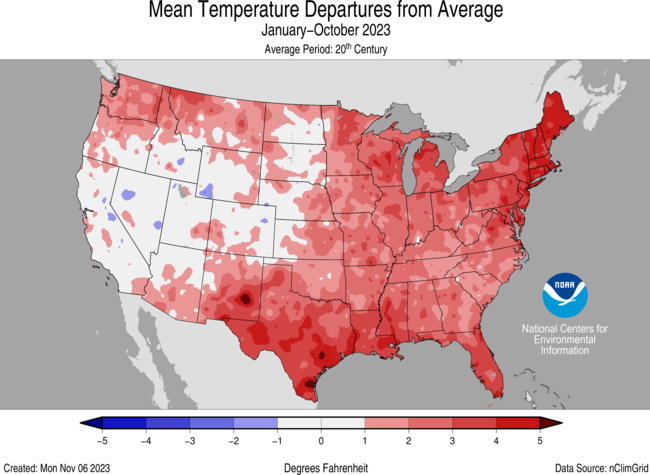
From January to October, the contiguous United States averaged 56.9°F, 1.9°F above average, ranking 11th warmest on record for the period. Temperatures were above average in parts from the Southwest to the East Coast and along much of the Northern Tier, with temperatures near to below average in parts of the Northern Plains to the West Coast. Texas, Louisiana, Mississippi and Florida ranked as warmest states on record, while Maine, New Hampshire, Vermont, Massachusetts, Rhode Island, Connecticut, New Jersey and Maryland ranked second warmest during the January-October period. An additional 18 states experienced the top 10 hottest periods year-to-date. No state experienced the 10 coldest from January to October.
Alaska's temperature from January to October was 31.5°F, 1.9°F above the long-term average, ranking third warmest in the state's historical record. Much of the state was above normal during the 10-month period while temperatures were near average in the western, south-central and interior parts of the state.
falling
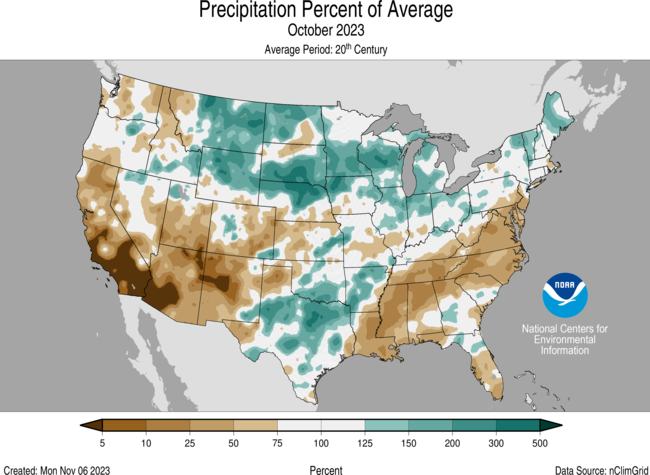
October precipitation for the contiguous United States was 2.14 inches, 0.05 inches below average, ranking in the middle third of the historical record. Precipitation was below average from the lower Mississippi Valley to parts of the mid-Atlantic and into parts of the Northwest, Southwest, Central Plains, and Southeast. Precipitation was above average from the northern Rockies to the Great Lakes and in parts of the Southern Plains, Southeast, and Northeast. No state ranked in the top 10 for wettest October on record for this period. On the dry side, North Carolina ranked as the 10th driest state on record for the month.
Across Alaska, average monthly precipitation was 4.06 inches, ranking third in the historical record. Precipitation was above average in parts of the North Slope, West Coast, eastern interior, and a small portion of the northern Panhandle. Below normal precipitation was observed in the Southwest, including the Aleutian Islands, south-central Alaska, and in southern parts of the Panhandle during the month.
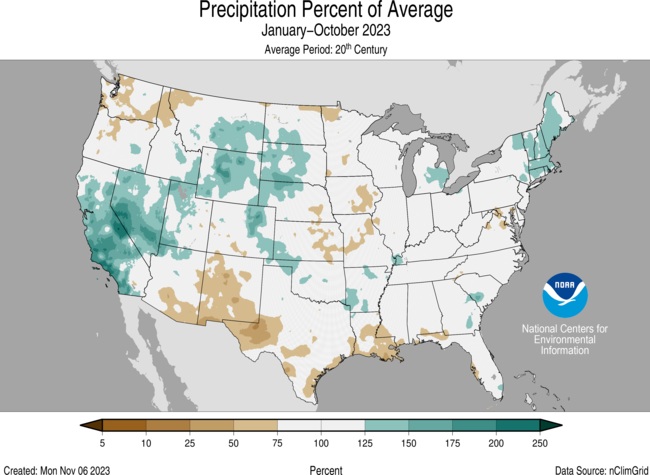
January-October precipitation totals for the contiguous United States were 25.50 inches, 0.14 inches above average, third off the 129-year record. Precipitation was near average across much of the Northeast, from California to the western Plains, as well as in parts of the Southern Plains, Great Lakes, and Southeast. Wyoming and Massachusetts ranked fourth wettest while Nevada, Maine and Connecticut ranked fifth wettest on record for this period of the year so far. Two additional states ranked among the 10 wettest states in this period. Conversely, precipitation was below average along portions of the northwest, southwest, upper and central Mississippi Valley, mid-Atlantic, and along the Gulf of Mexico during January to October. Maryland ranked seventh driest, while Washington ranked 10th driest during this 10-month period.
January-October precipitation ranked as the 15th wettest in Alaska's 99-year record, with above-average precipitation observed in most parts of the state. Near-normal rainfall was observed along parts of the Gulf of Alaska, while parts of the Aleutians saw below-average rainfall during this period.
Billion-dollar disasters

A new $1 billion weather and climate disaster was confirmed this month after southern hailstorms brought severe weather to parts of the southern Plains from September 23-24.
There have been 25 confirmed climate and weather disasters this year, each with losses exceeding $1 billion. These disasters consisted of 19 severe storm events, 2 flood events, 1 tropical cyclone, 1 winter storm, 1 wildfire, and 1 drought and heatwave event. For this period of year so far, the first 10 months of 2023 rank first in terms of the number of disasters, ahead of those of 2020 which saw 19 disasters. The total cost of the 2023 events exceeds $73.8 billion, resulting in 464 direct and indirect deaths.
The United States has experienced 373 separate climate disasters since 1980 where total damages/costs reached or exceeded $1 billion (including CPI adjustment through 2023). The total cost of these 373 events exceeds $2.645 trillion.
Other notable events
- Persistent heat brought record temperatures to parts of the United States during October:
A total of 317 counties experienced their warmest January-October on record, while an additional 1,498 counties ranked in the top 10 warmest counties for the year-to-date period. There are 3,143 counties in the United States - During early October, record warmth affected parts of the Northeast. On October 4, Vermont's Burlington Airport reached 86 degrees Fahrenheit and set a new October record high temperature — breaking the long-standing record high temperature of 82 degrees set in 1891.
- Above normal temperatures persisted in much of Puerto Rico during October. San Juan International Airport reported an average monthly temperature of 85.4 degrees Fahrenheit, making it the hottest October on record and the fifth warmest month on record.
- Warm temperatures and lack of precipitation during 2023 have extended the scope and severity of drought across parts of the Mississippi Valley, resulting in record low water levels along parts of the Mississippi River causing boats to run aground and creating fears of saltwater intrusion in south Louisiana.
Heavy rain and snow created one of the wettest water years — October through September — on record in California, pushing the state's reservoirs to 128% of their historical average.
Drought expanded in extent and severity across the Hawaiian Islands during October. On October 24, drought covered 94.8% of the state, the largest extent of drought in 2000-2023 according to the U.S. Drought Monitor.
drought
According to the U.S. Drought Monitor released on October 31, about 36.5% of the contiguous United States was in drought, down about 3.6% from the beginning of October. Moderate to exceptional drought spread across much of the central and southern Great Plains, lower Mississippi Valley, and Southwest, with moderate to severe drought across the Northwest, Tennessee Valley, Hawaii, and in parts of the Florida peninsula. There was moderate to severe drought in parts of the mid-Atlantic and New York, as well as moderate drought in parts of the Great Lakes and Puerto Rico.
Drought conditions expanded or intensified across much of the Southeast and Tennessee Valley as well as parts of the Southwest, mid-Atlantic and Hawaii this month. Drought has diminished or decreased in severity across much of the Plains and Great Lakes and in parts of the Northern Tier and Puerto Rico.
Monthly forecasts
According to the October 31 one-month forecast from the Climate Prediction Center, higher-than-normal average monthly temperatures are favored across much of the western United States, along the Gulf Coast states and much of Alaska in November, with greater odds for parts of United State. Southwestern United States and northern Alaska. Temperatures are expected to be below normal in parts of the northeast of the country this month. Portions of northwest, southeast, and northern Alaska are expected to see above-normal monthly precipitation totals while below-normal precipitation is likely to occur from the lower Mississippi Valley to the Great Lakes and in parts of southwest Alaska. Drought is expected to improve or eliminate along portions of the Pacific Northwest Coast and in parts of the Midwest, Southern Plains, and Puerto Rico, while drought is likely to persist across the Northern Tier, Southwest, Mississippi Valley, Ohio Valley, Mid-Atlantic, and Hawaii. Drought is likely in parts of the Southeast.
According to a one-month forecast issued Dec. 1 from the National Interagency Fire Center, Hawaii and parts of the lower Mississippi Valley have a high probability of wildland fires during November, while parts of eastern Oklahoma and western Arkansas are expected to have lower than normal fires. – Natural possibilities for this month.
this Monthly summary from NOAA's National Centers for Environmental Information It is part of NOAA's suite of climate services to government, business, academia, and the public to support informed decision-making. For more detailed climate information, see our comprehensive report for October 2023 US climate report It is scheduled for release on November 14, 2023. For additional information about the statistics presented here, visit Climate at a glance And National maps Internet pages.

